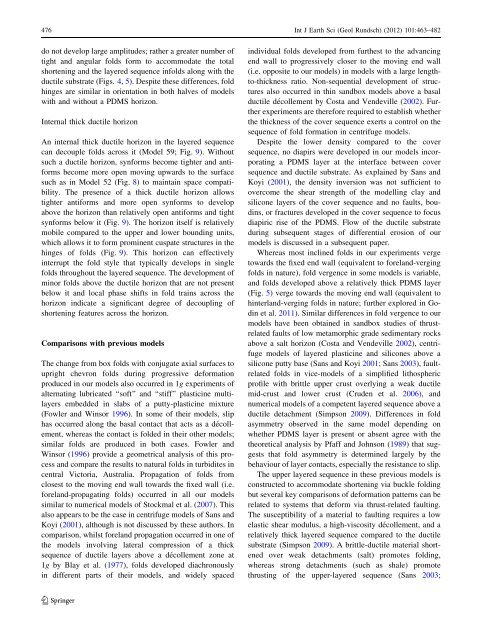Centrifuge modelling of deformation of a multi-layered sequence ...
Centrifuge modelling of deformation of a multi-layered sequence ...
Centrifuge modelling of deformation of a multi-layered sequence ...
Create successful ePaper yourself
Turn your PDF publications into a flip-book with our unique Google optimized e-Paper software.
476 Int J Earth Sci (Geol Rundsch) (2012) 101:463–482do not develop large amplitudes; rather a greater number <strong>of</strong>tight and angular folds form to accommodate the totalshortening and the <strong>layered</strong> <strong>sequence</strong> infolds along with theductile substrate (Figs. 4, 5). Despite these differences, foldhinges are similar in orientation in both halves <strong>of</strong> modelswith and without a PDMS horizon.Internal thick ductile horizonAn internal thick ductile horizon in the <strong>layered</strong> <strong>sequence</strong>can decouple folds across it (Model 59; Fig. 9). Withoutsuch a ductile horizon, synforms become tighter and antiformsbecome more open moving upwards to the surfacesuch as in Model 52 (Fig. 8) to maintain space compatibility.The presence <strong>of</strong> a thick ductile horizon allowstighter antiforms and more open synforms to developabove the horizon than relatively open antiforms and tightsynforms below it (Fig. 9). The horizon itself is relativelymobile compared to the upper and lower bounding units,which allows it to form prominent cuspate structures in thehinges <strong>of</strong> folds (Fig. 9). This horizon can effectivelyinterrupt the fold style that typically develops in singlefolds throughout the <strong>layered</strong> <strong>sequence</strong>. The development <strong>of</strong>minor folds above the ductile horizon that are not presentbelow it and local phase shifts in fold trains across thehorizon indicate a significant degree <strong>of</strong> decoupling <strong>of</strong>shortening features across the horizon.Comparisons with previous modelsThe change from box folds with conjugate axial surfaces toupright chevron folds during progressive <strong>deformation</strong>produced in our models also occurred in 1g experiments <strong>of</strong>alternating lubricated ‘‘s<strong>of</strong>t’’ and ‘‘stiff’’ plasticine <strong>multi</strong>layersembedded in slabs <strong>of</strong> a putty-plasticine mixture(Fowler and Winsor 1996). In some <strong>of</strong> their models, sliphas occurred along the basal contact that acts as a décollement,whereas the contact is folded in their other models;similar folds are produced in both cases. Fowler andWinsor (1996) provide a geometrical analysis <strong>of</strong> this processand compare the results to natural folds in turbidites incentral Victoria, Australia. Propagation <strong>of</strong> folds fromclosest to the moving end wall towards the fixed wall (i.e.foreland-propagating folds) occurred in all our modelssimilar to numerical models <strong>of</strong> Stockmal et al. (2007). Thisalso appears to be the case in centrifuge models <strong>of</strong> Sans andKoyi (2001), although is not discussed by these authors. Incomparison, whilst foreland propagation occurred in one <strong>of</strong>the models involving lateral compression <strong>of</strong> a thick<strong>sequence</strong> <strong>of</strong> ductile layers above a décollement zone at1g by Blay et al. (1977), folds developed diachronouslyin different parts <strong>of</strong> their models, and widely spacedindividual folds developed from furthest to the advancingend wall to progressively closer to the moving end wall(i.e. opposite to our models) in models with a large lengthto-thicknessratio. Non-sequential development <strong>of</strong> structuresalso occurred in thin sandbox models above a basalductile décollement by Costa and Vendeville (2002). Furtherexperiments are therefore required to establish whetherthe thickness <strong>of</strong> the cover <strong>sequence</strong> exerts a control on the<strong>sequence</strong> <strong>of</strong> fold formation in centrifuge models.Despite the lower density compared to the cover<strong>sequence</strong>, no diapirs were developed in our models incorporatinga PDMS layer at the interface between cover<strong>sequence</strong> and ductile substrate. As explained by Sans andKoyi (2001), the density inversion was not sufficient toovercome the shear strength <strong>of</strong> the <strong>modelling</strong> clay andsilicone layers <strong>of</strong> the cover <strong>sequence</strong> and no faults, boudins,or fractures developed in the cover <strong>sequence</strong> to focusdiapiric rise <strong>of</strong> the PDMS. Flow <strong>of</strong> the ductile substrateduring subsequent stages <strong>of</strong> differential erosion <strong>of</strong> ourmodels is discussed in a subsequent paper.Whereas most inclined folds in our experiments vergetowards the fixed end wall (equivalent to foreland-vergingfolds in nature), fold vergence in some models is variable,and folds developed above a relatively thick PDMS layer(Fig. 5) verge towards the moving end wall (equivalent tohinterland-verging folds in nature; further explored in Godinet al. 2011). Similar differences in fold vergence to ourmodels have been obtained in sandbox studies <strong>of</strong> thrustrelatedfaults <strong>of</strong> low metamorphic grade sedimentary rocksabove a salt horizon (Costa and Vendeville 2002), centrifugemodels <strong>of</strong> <strong>layered</strong> plasticine and silicones above asilicone putty base (Sans and Koyi 2001; Sans 2003), faultrelatedfolds in vice-models <strong>of</strong> a simplified lithosphericpr<strong>of</strong>ile with brittle upper crust overlying a weak ductilemid-crust and lower crust (Cruden et al. 2006), andnumerical models <strong>of</strong> a competent <strong>layered</strong> <strong>sequence</strong> above aductile detachment (Simpson 2009). Differences in foldasymmetry observed in the same model depending onwhether PDMS layer is present or absent agree with thetheoretical analysis by Pfaff and Johnson (1989) that suggeststhat fold asymmetry is determined largely by thebehaviour <strong>of</strong> layer contacts, especially the resistance to slip.The upper <strong>layered</strong> <strong>sequence</strong> in these previous models isconstructed to accommodate shortening via buckle foldingbut several key comparisons <strong>of</strong> <strong>deformation</strong> patterns can berelated to systems that deform via thrust-related faulting.The susceptibility <strong>of</strong> a material to faulting requires a lowelastic shear modulus, a high-viscosity décollement, and arelatively thick <strong>layered</strong> <strong>sequence</strong> compared to the ductilesubstrate (Simpson 2009). A brittle-ductile material shortenedover weak detachments (salt) promotes folding,whereas strong detachments (such as shale) promotethrusting <strong>of</strong> the upper-<strong>layered</strong> <strong>sequence</strong> (Sans 2003;123
















